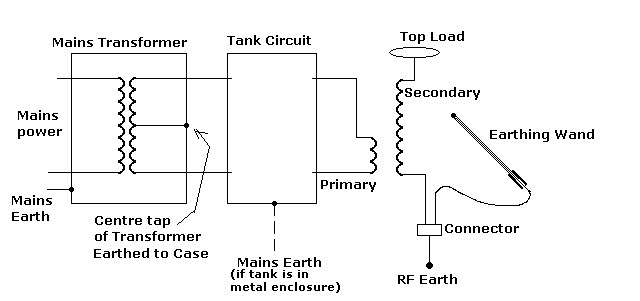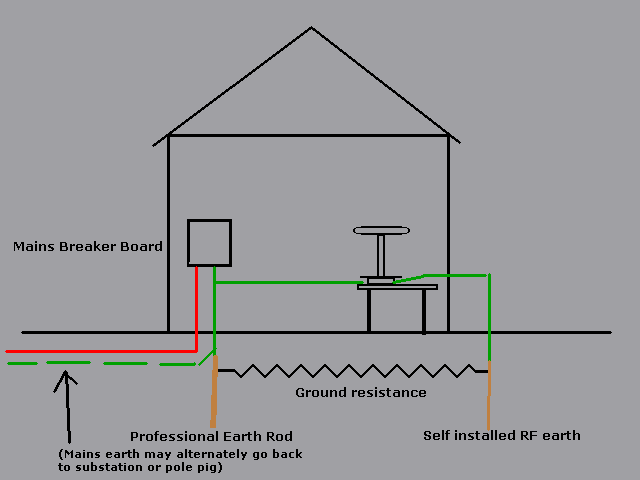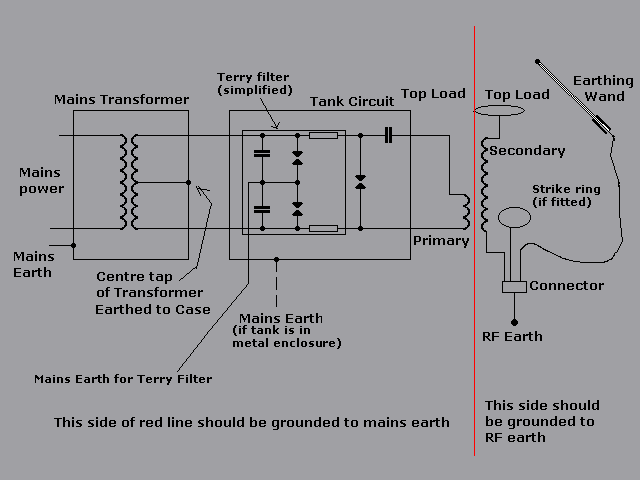Tesla Safety
Due to the high voltages and because part of the circuit operates in RF (Radio Frequency) there are a few guidelines you should be following. Here is my personal take on this after reading several articlesA basic set up for a Tesla coil is shown below.

We'll start with the mains side, The transformer is supplied from a mains outlet, so it makes sense that any earth should go through the proper mains earthing system, this is likely to be through a GFI (or RCCB if in UK), this meant that if anything shorts to earth, the earthing protection will come into play and shut off the power.
This also applies to when using any sort of metal case for the tank circuit.
The tank circuit may be a simple spark gap right through to a full blown electronic circuit with IGBT's, if there are any exposed metal parts, they should be mains earthed or insulated from touch.
Moving on to the secondary coil, this is operating at RF, all GFI's or RCCB's don't recognise this in fault conditions, but the coil needs to be earthed (bi-polar coils are different), the best way to earth this is to have a separate earth rod driven into the ground, (NOT the central heating as this is eventually connected to mains earth), and should be away from the mains earth rod.
I personally have the wire coming into my workshop with a connector on the wall, from this connector I can connect the secondary, and there's spare ways for an earthing wand and protective rod (protective rod is just a metal stand sited close to the coil for free arcs to contact).
The earthing wand is used to draw the arcs, and for discharging the secondary after use. You may question about discharging the secondary, but I can assure you through experience, the secondary also exhibits capacitive qualities, and can store a small static charge, after using the coil I disconnected the wires, then went to pick up the coil from it's base, I felt a few tingles, it wasn't bad, but was unexpected at the time as I assumed the RF earth would have discharged it, luckily this was just a small coil, i'd hate for someone to touch a large coil after use, so please remember to use the earthing wand on the windings of the secondary after powering down.
While we mention larger coils, if they are too large to power from the regular outlet, you must install a suitable supply (or have a professional install it) so that the mains side of your project is properly protected with the correct rating of protective device (over-current) and earth fault breaker.
notes:
GFI = Ground Fault InterrupterRCCB = Residual Current Circuit Breaker
The RCCB works by comparing the current going out on one leg of the mains, and the current coming back on the other leg, all being well, these should be the same, if the current in one leg is greater by a set amount, the circuit breaker will trip and disconnect the mains to that circuit, always test the device regularly, they usually have a test button on them.
If in any article you see people mention 'Playing with my Tesla coil' then you should assume that the person is referring to 'Safe play' following all the safety guidelines, to many coilers, these things are fun, there wouldn't be any point building them if they weren't.
Update
A question was raised about using a Terry filter, and where it should be grounded (mains or RF), so i thought it best to do a video to show why it should be grounded to the mains earthThis is the first diagram i mentioned in the video

The mains earth would have been done by a professional, and fully tested to carry fault currents
The RF ground is likely to be substandard for an electrical installation, but usually good enough for the very low current in a Tesla secondary.
Remember that the primary of a NST etc will be in Amps, it's secondary is likely to be mA, so the Tesla secondary has to be very much lower, and unlkely to do harm to you.
For instance, my 200watt coil would be about 500-800 microamps passing down the RF earth.
This diagram has been modified to include a simplified Terry circuit, as you can see it is centre tapped, it's that part which needs to be grounded to the mains side, in fact i have placed a red line, that should make things clearer.

You may freely link to any content or page. You may not hotlink any images etc You may copy any snippet of information providing you credit me with the creation